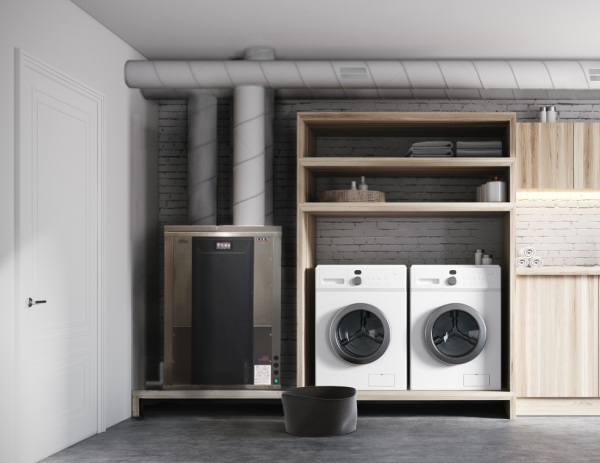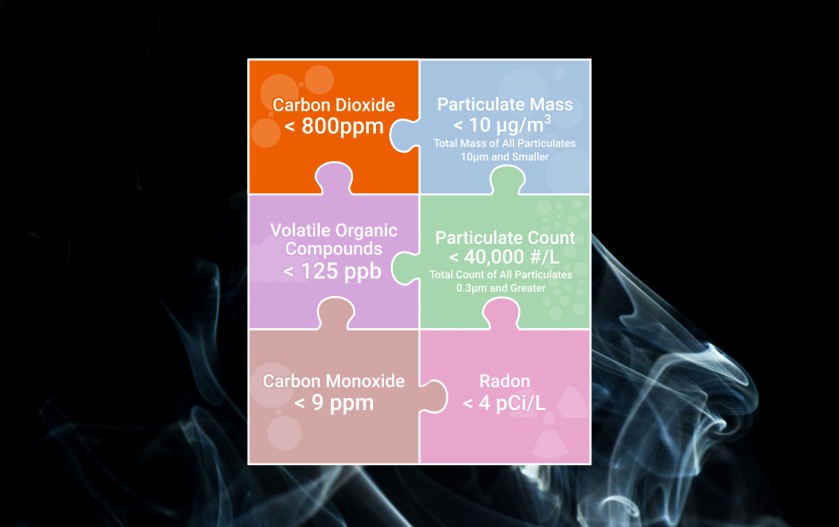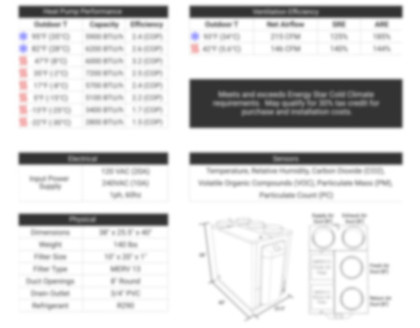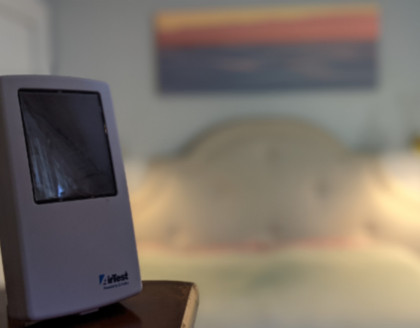Related Articles
newspaperHealthy Indoor Air Quality Standards: Volatile Organic Compounds (VOCs)
newspaperHealthy Indoor Air Quality Standards: Particulates (PC0.3 and PM10)
newspaperHealthy Indoor Air Quality Standards: Carbon Monoxide and Radon
A human placed in an initially sterile indoor environment will fill the room with unhealthy pollutants that degrade human health and well-being. Our IAQS is based on health in contrast to today’s “edge of sickness” ventilation standards. The gap between our healthy air quality standard and today’s ventilation standards is significant. The energy cost difference for healthy air is less than 2 cents per hour per person in harsh climates without energy recovery. Isn’t your health and the health of people around you worth 2 cents per hour? We know it is!
Controlling CO2 does not mean other pollutants are properly managed. CO2 is not necessarily degrading health, well-being and productivity, but it strongly correlates with other factors that impact us.
We recommended 800ppm of CO2 long ago in our February 2017 newsletter article for the same reasons we recommend 800ppm CO2 concentration today:
• You will get sick less often,
• You will sleep better, and
• Your brain function will be improved.
Since that time, Covid changed the world. Our March 2020 newsletter article was among the very first to explain and quantify how improved ventilation and filtration are essential for battling the spread of airborne contagions. Unfortunately, too many “authorities” refused to acknowledge the importance of airborne transmission of Covid at the time. A hard lesson learned, and one that should not be forgotten! Adopting our healthy IAQS will slow the spread of the next airborne pandemic contagion as well as reduce infections and fatalities.
Background
Dr Donald Milton and colleagues conducted a study of more than 3000 people working in multiple buildings. The researchers examined sick day absences and ventilation levels among the buildings. Doubling standard ventilation rates from 20cfm per person to 40cfm per person reduced sick days by 40%, or 1 work day per year. Doubling ventilation rates reduces carbon dioxide from 1200ppm to our recommended standard of 800ppm of CO2. Dr Milton examined even higher ventilation rates in a follow up study, finding a diminishing rate of sick day reduction at higher ventilation levels.
Sick day reduction is sufficient justification for our recommended 800ppm CO2 standard. For the US with 330 million people, a 40% reduction of illness, or 1 sick day less per year per person, is a cost savings of $165 Billion dollars per year! For perspective, domestic refrigerator annual energy cost is less than $10 Billion per year. The additional cost for better indoor air quality is $25 to 50 Billion dollars per year without adding energy recovery equipment. Energy recovery is beneficial and economical, providing manufacturing and installation employment opportunities in every community.
Sleep quality studies show 800ppm CO2 to promote restful sleep. A field study from the Danish Technical University (DTU), a pioneer in IAQ research, suggests 800ppm CO2 as a desirable level for sleeping quarters. The study also found, unsurprisingly, that poor sleep results in poor work productivity the following day. Bedrooms in “leaky” homes are relatively well-sealed with poor air quality and high CO2 concentrations.
A recent study further substantiates the earlier DTU results (“Reviewing How Bedroom Ventilation Affects IAQ And Sleep Quality”, ASHRAE Journal, April 2021, p56). Examining results from seven independent field studies confirms 800ppm CO2 is needed to achieve restfull sleep. Both self-reported and quantitative data (sleep sensors) show increasingly degraded sleep quality as CO2 increases above 800ppm.
The third area linked to carbon dioxide, cognition productivity, is a current area of research. Professor Joseph Allen (Harvard TH Chan School of Public Health) and colleagues correlated carbon dioxide concentration to 9 areas of cognition including creativity, information organization, and decision making. Their results indicated a 10% cognition decrease as CO2 at today’s ventilation standards.
An economic analysis of the cost of doubling today’s ventilation standards led by Harvard’s TH Chan School of Public Health, found ventilation energy cost increases would be less than $50 per employee per year in harsh climates without adding energy recovery systems. The study estimated $6500 per employee per year for the 10% productivity increase, more than 100 times the potential energy cost increase. An actual productivity gain only 1/10th of the study’s prediction is still worth 10 times the potential energy cost. Humans are more valuable than energy!
Finally, Wargocki and colleagues examined air quality impact on K12 school children (“The relationships between classroom air quality and children’s performance in school”, P. Wargocki, J.A. Porras-Salazar, S. Contreras-Espinoza, W. Bahnfleth, Building and Environment 173, 2020). Results from 18 research studies involving more than 15,000 students could not be more clear. Reducing CO2 concentration improves student reaction speed, improves school work accuracy, increases test score performance, and reduces sick days!
As noted by the authors, every 100ppm decrease of CO2 is correlated to successfully greater improvements in each category. That is, improvements gained by decreasing CO2 from 900ppm to 800ppm is greater than the improvement gained by decreasing from 1000ppm to 900ppm. Also noted by the authors is that each 100ppm reduction in CO2 concentration requires higher levels of air flow. For example, decreasing CO2 from 2000ppm to 1200ppm is an increase from 10cfm/person to 20cfm/person, and a decrease of CO2 from 1200ppm to 800ppm is an air flow increase from 20cfm/person to 40cfm/person.
Wargocki, et.al. found student work speed to increase by more than 10% and work accuracy improved more than 2% when CO2 is reduced to 900ppm. The authors noted continuing improvement trends in all areas as CO2 is lowered below 900ppm, the lower concentration limit for their classroom data. Test scores improved by 5%, which is a cumulative measure of classroom air quality impact on student learning. Finally, the authors state that classroom attendance is improved by 2.5% per day, which would be 1 less student absence every 2 days for a classroom with 20 students!
Human performance impacts can be compounded, too. Poor air quality that impacts a teacher’s performance may impact student learning because of less effective teaching. Increased absences due to poor air quality impacts student learning and performance. We all pay a price when our children, our future, are placed in substandard learning environments. 2 cents per hour per student to provide healthy air to our children is a bargain with an enormous beneficial payback.
Summary
The data from multiple field studies are clear. Increasing fresh air and reducing carbon dioxide concentration results in valuable savings that far outpace potential energy cost increases. Build Equinox healthy IAQS recommendation of maintaining CO2 concentration less than 800ppm will improve human performance, improve sleep (and next day’s productivity), and reduce sick days.
Related Articles
newspaperHealthy Indoor Air Quality Standards: Volatile Organic Compounds (VOCs)
newspaperHealthy Indoor Air Quality Standards: Particulates (PC0.3 and PM10)
newspaperHealthy Indoor Air Quality Standards: Carbon Monoxide and Radon
























